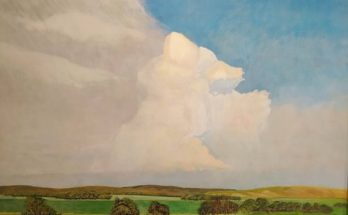By Zonia Torres Saeb
San Miguel has been an “art town“ for a long time with distinguished writers, musicians, painters and sculptors attracted here by the beauty, history and general ambiance of the city. Seven years ago another expatriate artist was charmed by San Miguel and decided to leave Los Angeles after 32 years and move here with his wife and son. His dream from day one was to create and erect a work of public art. That dream came true when George Kalmar’s 6 meter sculpture entitled “Free at Last” was installed in front of the new City Market on November 6, 2021.
ZT: Was it difficult to leave the big city and you art career in Los Angeles.
I was lucky to be involved with a wonderful gallery in Los Angeles. They gave me an opportunity to exhibit my work in many paces including the Cultural Center in Bangkok, the Metropolitan Museum of Art in Tokyo, and other wonderful places. As much as I recognized the potential of continuing a good career in Los Angeles, the lifestyle was increasingly difficult and I kept wanting something new. When I got to know San Miguel, there was no question in my mind that I had found what I was looking for.
ZT: You didn’t want to return to Europe?
Honestly, no. I like staying close to the US and besides, we have a wonderful daughter who lives in Los Angeles and our son just started at UC Davis also in California.
ZT: Does the sculpture you put up on the Ancha express any of these feelings about San Miguel?
GK: Oh yes, very much so. First, I was aware of the fact that many expatriates here have helped to make life better in San Miguel with their financial support and their personal effort, and I knew it was because, like me, they love this city and its people. So I wanted to create something that will express our appreciation in a more public manner. The sculpture is my way of saying “Thank you” to this city, its people and its municipal government. They have been good to the expatriates here.
ZT:But the sculpture seems to be more about the past history of San Miguel.
Yes, I am fascinated by the past in general. One day we will be in the distant past and don’t you want people to at least remember us and the efforts we made in our lives?
GK: Well, Mexico in particular has a very rich history and a lot has happened here in the San Miguel area and I wanted to expose it in my sculpture.

ZT: You start at the very beginning.
GK: Yes there are five pieces of metal and cantera in the sculpture. The bottom one represents the pre-historic times when this area must have been very beautiful That and the availability of water is what must have drawn the indigenous population to this place. The next piece is a person on their knees and it represents the subjugation of the indigenous people. To me this is a particularly sad but important part of Mexican history. The indigenous part of Mexican culture is what I find most interesting. It is a part of everything here. It should not only be preserved but elevated to a higher status. And part of respecting it is to acknowledge the injustices and the pains of the past – that is why I put that piece in the sculpture.
ZT: So what is the stone with the cross on it?
GK: Well, San Miguel would not be what it is if it were not for the Spanish and later the Mexican church and its churches. The churches of San Miguel are not only amazing architectural treasures, but they have supported and enriched the lives of the local community for centuries. So that part of the sculpture represents the epoch when the churches and the wonderful homes were built here. The piece above it is the eagle from the Mexican flag that represents the war of independence and the subsequent war of 1911. Mexico seems to always be fighting for its independence at first from the Spain and always from its Northern neighbor. And then the last piece on top of the sculpture represents friendship and coexistence between all the people in San Miguel. It is a series of equal and mutually supportive elements – and that is the way I see our community here. (END)
At the end of my interview with George he pointed out that his sculpture may also be unique in that it is more abstract than all of the sculptures in San Miguel. He hopes that he has started a trend to attract and install more modern and abstract sculptures in the city. I for one was happy to see more contemporary work in our town with some historical significance and such a deep meaning to the artist himself.




